
Welcome to the lush world of gardening where every soil amendment holds the promise of greener pastures and thriving blooms. Among the myriad of options available, there’s one humble yet mighty component that often goes unnoticed – peat. Tucked away in bogs and wetlands, peat has quietly earned its reputation as a gardener’s best-kept secret, enriching soil and nurturing plants in ways that are nothing short of magical. In the Blog Post, we’ll delve into the depths of peat’s virtues, exploring it origins, properties and the many ways it can transform your lawn and garden into vibrant, flourishing sanctuaries. So, let’s embark on a journey to unlock the mysteries and marvels of peat.
The newest addition to the Tim Wallace Soil Mix Supply amendment offerings is Peat. It can be purchased as a standalone amendment, or blended into one of the these new Mixes –
- Peat Garden Mix
- Peat Lawn Repair Mix
- Peat Topdressing
- Peat Raised Bed Mix
Just as there are different types of compost, there are different types of peat: Sphagnum moss and Peat.
Sphagnum Moss
The key difference between peat and sphagnum moss is that sphagnum moss is typically harvested as a living plant, whereas peat is dead fibrous material that forms when mosses and other living material decompose in cold water peat bogs.
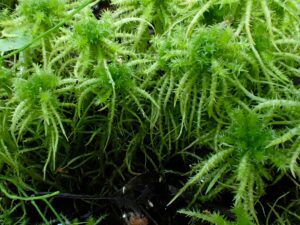
Sphagnum moss grows on the surface layer above of the bog. As time goes by, the sphagnum sinks into the lower layer of the bog where it decomposes slowly over time in the oxygen-less layer. Most gardeners are familiar with seeing sphagnum moss used to line wire baskets for hanging plants to retain the soil. While peat resembles soil, you’ll likely find bright green sphagnum moss – which was a living plant not very long ago, lining the top layer of potted houseplants. Sphagnum moss offers very little benefit for the garden or lawn. It is best used as a seed-starter, to line baskets, for growing orchids, and as additional growing material in potting soil mixes.
Peat
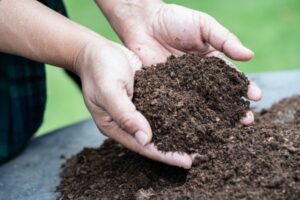
“Peat” is not alive; it’s long dead. Peat comes from peat bogs, many of which are found in the wetland areas of northern Midwest states, Canada, Europe and even New Zealand. Peat bogs are formed over long periods of time as organic materials such as sphagnum moss become submerged and partially decompose. Since there is an abundance of water in these bogs, the decomposition of this organic matter is slowed by the anaerobic (without air) conditions present. The product created from organic matters submerged into the bogs is called peat. And because this material is essentially formed underwater, the peat is preserved almost indefinitely.
Concerns Regarding the Use of Peat 1
One of the concerns regarding peat is that it’s not really renewable since the process of decomposing the peat takes years. Therefore some considered it to be non-renewable and not eco-friendly. Another common misconception is that peat is “over harvested”. However, this is not true. Peat is renewable and grows more than 70 times as fast as it is being harvested. But for those still have concerns over using peat in their lawn or garden, composts remain the solid alternative.
Peat Alternative: Compost
Any acceptable substitute for peat comes down to cost, personal preference and environmental awareness. The alternatives to peat share some great qualities with peat but are often blended with one another to get peat’s best traits. These alternative amendments fall into the category of “organic soils” or simply “compost”.
Compost
Compost consists of decomposed organic material, but it decomposed in the presence of the air. Meanwhile, for peat to form, the air is absent. Compost is the result of decayed organic materials like grass clippings, plant materials, leaves, vegetable scraps and sometimes, animal manures. Each gardener can make their own compost or source it locally, ready-made.
Although both are considered soil amendments, there are some differences between peat and compost:
Peat
- Possess a low pH (ie. Acidic)
- Does not compact
![yard soil]()
- Holds moisture better than compost
- Has a uniform composition
- Poor in microorganisms
- Contains few nutrients
- Is weed seed free
- Can be more expensive than compost
Compost
- pH neutral
- Often self-compacts
![shovel compost]()
- Doesn’t hold water as well as peat
- Depending on the source doesn’t have a uniform composition
- Rich in microorganisms
- Made from recycled organic matter
- Holds more nutrients
- Not always weed-seed free
- An economical amendment when purchased, or – can be free if created on your own
Among the other concerns and misconceptions about the use of peat:
- Peat has an over-abundance of salt / fine silts in it. However, there is no evidence to support this claim.
- Peat adversely affects the physical dynamics of a root zone. Again, no evidence to support this claim. Peat actually helps to keep your root zone rich in nutrients by releasing water and nutrients when needed.
- Localized dry spots can be caused by peat. This is also not true. Yes, you still need to add water to a peat soil. But peat is what you use to repair dry or bare spots.
- Peat can be used interchangeably with mulch. Not a good idea. Peat should be used as a soil amendment rather than a mulch (top covering) layer.
Benefits Regarding the Use of Peat 2
- Peat has a reliable pH (3.4 to 4.8); is environmentally friendly, free of insects, weeds, seeds, salts, and chemicals.
- Peat helps to repair bare spots caused by things like: disease, animal urine, soil compacting, winter burn and thatch.
- Peat retains 20 times its weight in moisture. It also releases the water slowly as the plants need it. This is known as “Cation Exchange Capacity” or CEC.
- Peat allows for room for growth. Peat allows for proper growth by loosening and
aerating soils. - Peat helps bind sandy soil by adding body to your mixture and also helps to retain moisture and nutrients.
- Peat reduces the loss of nutrients. Peat reduces the leaching of nutrients that are in or are added to the soil. This helps save time and money on fertilizer.
- Peat protects the soil from hardening and adds organic material.
1, 2 This information regarding peat was published by the North American Wetlands Conversation Council.
How to Best Use Peat
Peat is not commonly used as a standalone product. In fact, by itself it’s not a good growing medium beyond starting seeds from scratch. Even though peat can help your soil retain nutrients, it hardly contains any nutrients at all in and of itself. Peat also doesn’t add sufficient nutrients to the soil for healthy plant growth on its own so you have to add other organic components like topsoil along with it.
As a Soil Amendment
- Water Retention: One of the significant attributes of peat is its ability to retain water. Its fibrous structure
![raised bed soil mix]() creates pore spaces within the soil, enhancing water retention and preventing rapid moisture loss. This quality proves particularly useful in soils that tend to dry out quickly – like clay.
creates pore spaces within the soil, enhancing water retention and preventing rapid moisture loss. This quality proves particularly useful in soils that tend to dry out quickly – like clay. - Organic Soil Amendment: Peat serves as an excellent organic amendment, enriching the soil with organic matter as it decomposes further over time. This enrichment fosters a favorable environment for beneficial microorganisms that contribute to soil health. Peat can be added to your soil to achieve any of the following results:
- Help drier, sandier soils retain moisture for longer.
- Help heavy clay soils loosen up and have better aeration and drainage.
- Its fibrous nature facilitates better soil drainage and root development.
- Increase the amount of organic material in the soil, which breaks down over time to provide nutrients.
Gardening experts seem to unanimously agree, that peat used in a ratio of no more than 3 to 1 is the best soil blend combination. We prefer a slightly more conservative approach and blend our soil mixes made with peat at a rate of 25% peat. This percentage amount provides the moisture and nutrient retention qualities of the peat that complement and improve the other organics used in the blend while not making drastic changes to the soil’s pH.
FOR THE LAWN
Peat moss is often added to soil to lighten, aerate, and help retain moisture. Although peat is good for keeping in moisture and aerating the soil, peat alone is not often used for lawns since its low pH / acidity hinders grass growth and can kill earthworms. This is one reason why we suggest introducing peat into the lawn as a component of a soil blend.
If you’re considering using peat on your lawn, we recommend that you do a pH test of your soil before and after to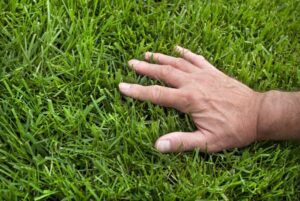 measure results. (Soil test kits are sold at many home-improvement garden centers and often can be done for you through your state or county agriculture extension.) Ideal pH for both lawns and vegetable gardens should be between 6.5-7.0 – slightly acidic. Traditionally, elemental Sulphur was added to lower the pH of a lawn. Lime was conversely used to raise the pH. For those who wish to avoid these chemical applications – especially in the garden, peat is the perfect choice. Since here in the Midwest most native soils tend to be neutral to slightly alkaline – (pH of 7.0 and above) adding peat to the lawn (or garden) when used in a quality soil blend can improve the soil while gently lowering the pH to within the optimal range. If your soil tests within the 6.0-6.9 range (or lower), consider a soil blend that uses compost rather than peat so you do not reduce your soil’s pH into a much too acidic state.
measure results. (Soil test kits are sold at many home-improvement garden centers and often can be done for you through your state or county agriculture extension.) Ideal pH for both lawns and vegetable gardens should be between 6.5-7.0 – slightly acidic. Traditionally, elemental Sulphur was added to lower the pH of a lawn. Lime was conversely used to raise the pH. For those who wish to avoid these chemical applications – especially in the garden, peat is the perfect choice. Since here in the Midwest most native soils tend to be neutral to slightly alkaline – (pH of 7.0 and above) adding peat to the lawn (or garden) when used in a quality soil blend can improve the soil while gently lowering the pH to within the optimal range. If your soil tests within the 6.0-6.9 range (or lower), consider a soil blend that uses compost rather than peat so you do not reduce your soil’s pH into a much too acidic state.
Peat offers a range of benefits in lawn care. This versatile component plays a pivotal role in maintaining soil balance thanks to its ability to regulate pH levels, retain essential moisture and supply vital nutrients. Its weed-suppressing properties are equally crucial, as it forms a dense topsoil layer that ensures your grass can flourish without having to compete with unwanted intruders. Whether you’re contending with clay-heavy soils or sandy landscapes, peat comes to the rescue by enhancing drainage in the former and facilitating aeration in the latter. In summary, incorporating peat is a wise decision for bolstering the vitality of your grass. If your ultimate goal is to achieve a lasting, vibrant lawn, peat can create an ideal environment for your plants to flourish, all while curbing weed growth and improving soil drainage – a winning recipe for lush and enduring greenery.
One of peat’s fundamental roles is as a key component in top dressing for grass and lawns. Its lightweight and airy characteristics make it a great choice, especially during hot and dry summers, as it excels at retaining moisture in the soil, providing vital protection against wilting in the scorching sun. It proves particularly advantageous in sandy soils where moisture retention is needed. This organic material can be applied in late fall, once your lawn is cleared of leaves and other debris, or, in early spring while the grass is just beginning to green up. What’s more, the light and fluffy texture of peat simplifies the establishment of grass seedlings, making it a valuable addition to your lawn maintenance routine. When applied as a top dressing either without or after seeding, peat contributes to a healthy and thriving lawn, ensuring that your outdoor space remains lush and vibrant throughout the seasons.
FOR THE GARDEN
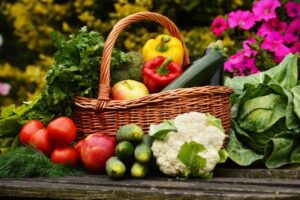 For the garden, peat can be tilled into a planting bed where the soil is not sufficiently friable. Friable soil contains the proportions of dirt, silt and sand (the constituents of soil) that result in an ideal crumbly texture. By not being too heavy (in other words, holds lots of water) and not too light (holds little water), friable soil provides the best soil for water, nutrient and organic matter retention. This is what we are looking for in our gardens so we can get the best from our plants. Peat will also lighten up the soil in your garden, which may have become compacted over the years, resulting in inadequate drainage.
For the garden, peat can be tilled into a planting bed where the soil is not sufficiently friable. Friable soil contains the proportions of dirt, silt and sand (the constituents of soil) that result in an ideal crumbly texture. By not being too heavy (in other words, holds lots of water) and not too light (holds little water), friable soil provides the best soil for water, nutrient and organic matter retention. This is what we are looking for in our gardens so we can get the best from our plants. Peat will also lighten up the soil in your garden, which may have become compacted over the years, resulting in inadequate drainage.
Peat offers a range of benefits when incorporated into your gardening practices as a soil amendment. Its ability to loosen compacted soils, enhance aeration, and improve overall soil structure is invaluable. What’s more, peat is a natural source of essential nutrients and beneficial microbes, creating an ideal environment for robust plant growth. Its water retention properties are particularly noteworthy, ensuring your garden remains consistently hydrated, and reducing the need for frequent watering. Additionally, peat not only suppresses weeds but also maintains a cool and moist environment for your plants. For those starting seeds or nurturing young plants, peat is an indispensable ally, making it a must-have for anyone embarking on a gardening endeavor.
In the vegetable garden, peat helps to moderate extremes in soil dryness and wetness. This is particularly important when growing juicy-fruited plants with tender skins, such as tomatoes, strawberries and blueberries. In fact, these acid-loving plants — and many other fruits and vegetables — benefit from peat’s lower pH. The product’s sterility means it won’t introduce weeds, diseases or pathogens that can quickly ruin a vegetable garden. Peat is suitable for a wide range of vegetables, including tomatoes, peppers, cucumbers, and lettuce.
Tim Wallace Soil Mix Supply & Nursery specializes in creating superior soil blends for lawns and gardening throughout the west and southwest suburbs. Our new line of soil blends using Peat might be perfect for your lawn or garden need. Check out our Peat Soil Blends page for the options. (www.timwallacesoilmixsupply.com) We blend on-site quality materials to insure you receive a quality soil mix. To see soil mix samples or pick up a soil mix, visit us at 1481 W. Boughton Road (Bolingbrook). If you’d like to place an order or further discuss your lawn and gardening soil needs, simply call us at (630) 759-1080.
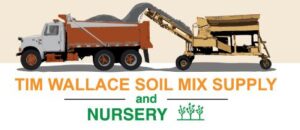


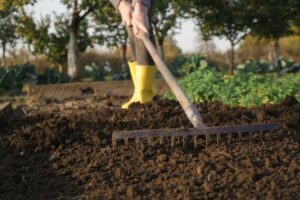
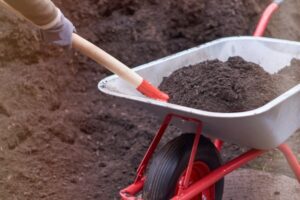
 creates pore spaces within the soil, enhancing water retention and preventing rapid moisture loss. This quality proves particularly useful in soils that tend to dry out quickly – like clay.
creates pore spaces within the soil, enhancing water retention and preventing rapid moisture loss. This quality proves particularly useful in soils that tend to dry out quickly – like clay.